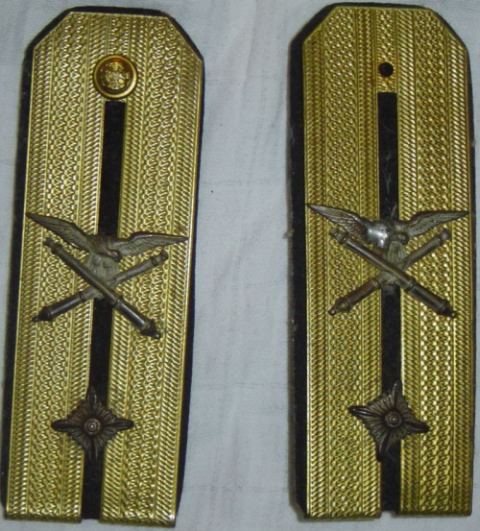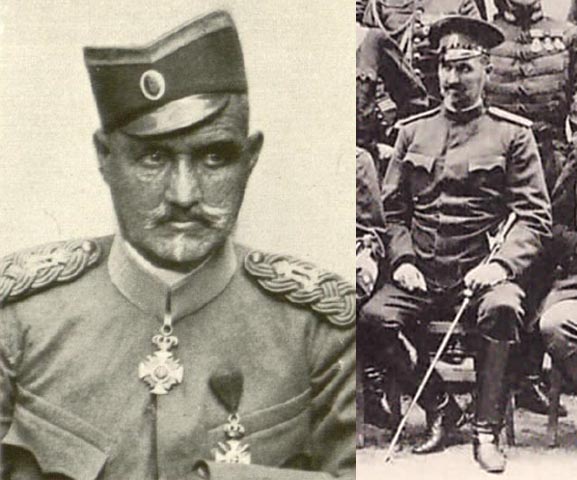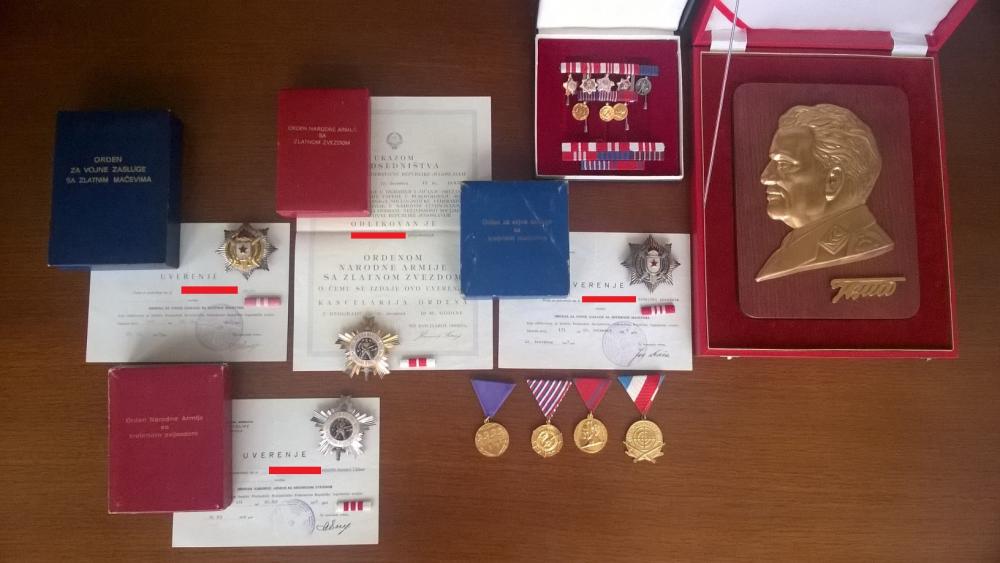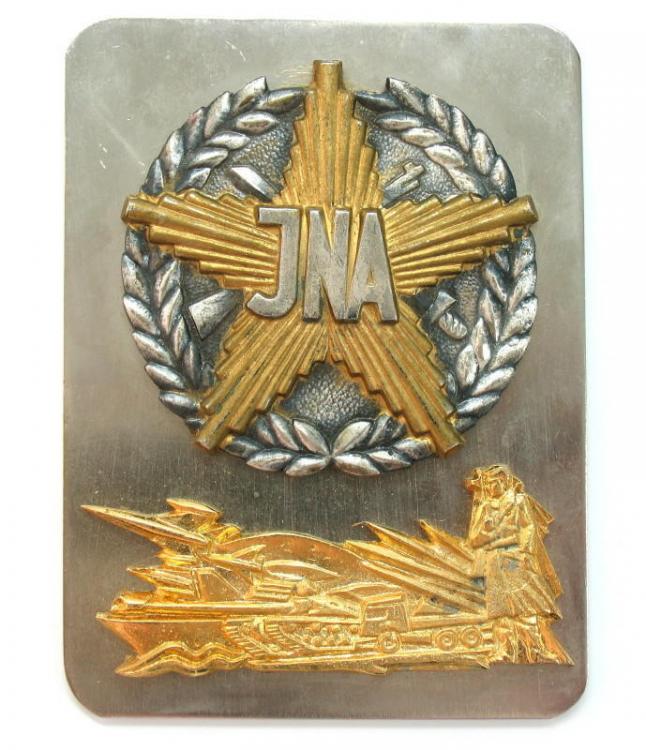-
Posts
3,629 -
Joined
-
Last visited
-
Days Won
1
Content Type
Profiles
Forums
Blogs
Gallery
Events
Store
Posts posted by paja
-
-
According to family history ancestor brought this blanket home after the war ended. My grandmother was using it for ironing for decades hence the brownish burn marks.
Can anyone confirm that it really is a Great War military issue blanket? I've being doing some online research and looks like the Americans used something very similar, perhaps part of foreign help?0 -
Thanks, I wasn't really sure. Some of the shoulder board signs were exactly the same as the royal ones. Anti-aircraft artillery sign is not the same but it's pretty similar, here's how it looked like before:

Anti-aircraft artillery 2nd lieutenant's M1939 shoulder boards posted on GMIC by Valter.0 -
Thanks for clarification, perhaps that document accompanied the YPA plaques...
Anyway it was signed by Nikola Ljubičić but I think it's a facsimile signature.0 -
It's mostly about open competitions but here's an article about German visit.

German officers visit the French Cavalry school in Saumur
Paris, July 18th (1934.)
Another delegation of German officers led by the commander of the German Cavalry school in Hanover, general Dalwigk, visited French Cavalry School in Saumur on Monday and Tuesday.
German flag was erected during the visit.
French officers organized luncheon for German officers who afterwards laid a wreath at the monument of the fallen French cavalrymen.
More information about general Dalwigk (1876-1947) can be read HERE.
He was the school commander from October 1931 until March 1937.Very interesting topic with his medal bar and photos, here on GMIC, LINK.
0 -
-
2nd Lieutenant Nedeljko Lošić (Недељко Лошић) in M1943 uniform probably wearing Bravery Medal.
0 -
Looks like 1909 to me as well. Based on the uniform of the Serbian officer and Petar I Coronation Medal, the photo had to be taken between 1904 and 1911.
You are right, same country different name, Kingdom of Serbs, Croats and Slovenes until 1929, Kingdom of Yugoslavia later.
I dug up a few more information from the interwar era, I know this topic is dedicated to pre-WW1 period but if someone's interested I can post it.0 -
Great scan! Thank you very much for posting it!
I've been going through the Official Military Gazette and came across some information regarding this matter. Kingdom of SCS/Yugoslavia continued sending officers to French military schools during the twenties and the thirties.Open competition from 1921:
-Two artillery officers will be sent to the School of applied artillery in Fontainebleau
-Two cavalry officers will be sent to the School of applied cavalry in Saumur
-Two artillery officers will be sent to the School for anti-aircraft defense
-Two officers will be sent to the Center for assault cars training in VersaillesOne of the conditions - rank of captain or major.
0 -
I posted this one a few days ago in a different topic, not really orders or medals but still somewhat interesting.
Anti-aircraft artillery (? - wings and crossed cannons) NCO in M1946 uniform with three udarnik (shock worker) badges.0 -
15 hours ago, Trooper_D said:
Here is a rather better image of the Military Attachés of 1902.
Von Hugo dominates the centre of the group, our friend Mott is, as always, striking a jaunty pose (middle row, right), and the Serbian officer can be seen rather more clearly than in the previous image (fourth from the right).
The Chilean officer (bottom row, right) has a beard to envy - although it looks like the kind you take off before you go to bed, to my eyes

Excellent! Thanks for uploading that post card, here's why I'm pretty sure Serbian representative is Mihailo Živaković.
 0
0 -
Infantry lieutenant colonel in M1955 uniform wearing Partisan Commemorative Medal 1941.
0 -
Thanks for the link, interesting article.
If Bulgarian "Medal for Bravery" is the one we can see in the pictures then there's some kind of mix up. Bulgarian medal from the images is actually Medal for the Patriotic War 1944-45. I think there were many Yugoslav recipients as they pop up pretty often on the market, at least in Serbia.0 -
Don't mention it, I was really hoping I would find something. So far the only Greek recipient of the White Eagle I stumbled upon in the press is foreign minister Politis (1918), that's it. Unfortunately most of the names from the list have zero search results...
0 -
17 hours ago, BalkanCollector said:
I've finally bought my first 3rd class star of this order (IKOM, Yugoslav made type). The hallmarks look good under the magnifier. It looks even more beautiful in my hands.
Congrats, a nice looking pieces and a great addition to your collection
 0
0 -
Digging up recipients of the Serbian decorations, especially foreign ones, is very problematic.
First of all, records kept at the Chancellery of Orders were destroyed during WW2. There's the Official Military Gazette, but unfortunately not all numbers are available online, over ten years are missing and some years are incomplete. Apart from that, generally speaking, names of the foreign recipients were not being published in the Gazette.
There are Schematisms but only for the XIX century and only for the Serbian citizens who were among the living at the time. They are not available online and very hard to find, practically only a few libraries in Serbia have them in possession.
Main source I used for digging up some foreign recipients were newspapers from that era, unfortunately, so far that was a dead end.
Once I catch some free time, I'll check every name from the list you published. Earliest records of Metaxas' name in the Serbian press are from 1915.0 -
There can't be that many Yugoslav recipient so great news if it's really Albanian ribbon
 0
0 -
Thanks for the photo and the link.
Although not listed, Serbian representative can be seen on the photo as well, he's on the 8th place from the left, barely visible between "France" and "Switzerland". Based on some other photos I've seen I'm pretty sure that's colonel Mihailo Živković (Михаило Живковић), future general and minister of the military in the Serbian government.0 -
Excellent topic and a great collection, I especially like IKOM made pieces.
Just a small suggestion, it would be great if you could write down names of the decorations you posted with some basic info like class, producer etc. That would be helpful to those who are not that familiar with Albanian decorations.0 -
Most interesting, thanks for additional information. I'm currently translating TV documentary about Pancho Villa and the Mexican Revolution, so perhaps Mondragon's name will pop up.
0 -
And how about Albanian Bravery Medal? Here's an illustration from Lukasz Gaszewski's website:

Looks pretty similar to me and it fits the time frame. That medal was introduced in July 1945, and the photo was made somewhere between late 1944 and 1946.0 -
What a pity! As you already wrote 2nd class boxes are rare so it hard to say what would be realistic price now.
I presume it has "ORDEN PARTIZANSKE ZVEZDE SA SREBRNIM VENCEM" inscription on the lid, that means it was made after March 1961. The box is for the needle variant and I don't remember seeing IKOM made 2nd classes with needle, of course that doesn't mean they don't exist.0 -
Don''t mention it.
Looks like Bentley-Mott attended the "Grandes manœuvres de l'Est" in 1901 as well.
Switzerland: Secretan, colonel; Baumann, lieutenant colonel
Denmark: Kranold, general of the 1st Jutland brigade
Peru: Althaus, colonel
Italy: Barattieri di San Pietro, colonel, embassy attache
Belgium: Theophile Wahis, colonel
Bulgaria: Nazlamov, colonel of the 1st cavalry regiment;
Portugal: Antonio Rodrigues Ribero, colonel
Serbia: Svetislav Isaković, engineer colonel
Mexico: Mondragon, artillery colonel
Russia: Lazarev, lieutenant colonel, military attache; Dmitri Oznobishin, captain
Greece: Soutzo, lieutenant colonel, Cavalry school commander
England: Edward James Montagu-Stuart-Wortley
Japan: Akachi, lieutenant colonel, military attache
Netherlands: Van Voorst, lieutenant colonel
Spain: Francisco Echagüe y Santoyo, military attache
Argentina: de Vedia, military attache
Germany: von Hugo, squadron commander, 3rd guards uhlan regiment
Austria-Hungary: count Herbenstein, military attache
Sweden: Heftye, military attache
Romania: Miclesco, military attache
Ecuador: Gagliardo, military attache
United States: Bentley-Mott, military attachePhoto and the list found HERE
0 -
Apologies for not replying sooner, I really appreciate your willingness to help.
Wound badge didn't even cross my mind, though when I look at the photo it seems like a single ribbon with two darker stripes, at lest to me. I'm really not sure.0 -
Two "tough guys"
 I presume the soldier on the right is wearing Bravery Medal, but 2nd lieutenant's ribbon is a puzzle to me, perhaps something foreign...0
I presume the soldier on the right is wearing Bravery Medal, but 2nd lieutenant's ribbon is a puzzle to me, perhaps something foreign...0




Socialist Yugoslavia Documented Groups
in Southern European & Balkan States
Posted
Apologies for not being more clear, I meant perhaps documents such as the one I posted were given together with YPA (JNA) plaques. If I remember well there were several different plaques, small, medium and large. This really isn't my field so don't take my words for granted.

Here's one example from ebay with a crazy price.
LINK